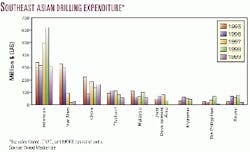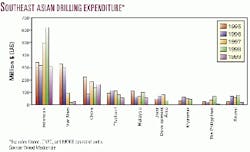SE Asia exploration drilling rebounding in some areas
Certain areas in Southeast Asia continue to attract the attention of oil and gas companies looking for exploration opportunities despite fallout from the economic crash of 1997 and the oil price collapse in 1998.
China, in particular-with its growing number of successful oil wells in Bohai Bay and the Pearl River Mouth basin and initial movement toward development of a domestic gas industry-will likely receive the bulk of companies' attention in months to come, according to a new analysis by Wood Mackenzie.
These are some of the key findings the analyst made in a recent report on exploration trends in Southeast Asia. The report covers Brunei, China, Indonesia, Malaysia, Myanmar, the Philippines, Thailand, Viet Nam, and the Joint Development Area between Malaysia and Thailand.
The analyst said that reinvestment rates, however, have remained relatively low: "Southeast Asia has been relatively unsuccessful in attracting reinvestment in exploration. Moreover, a number of companies have invested heavily in exploration in Southeast Asia with limited return."
Following are additional findings from Wood Mackenzie's report:
- During 1995-98, an average of $1.2 billion/year was spent on exploration projects in Southeast Asia (excluding the Zone of Cooperation between Australia and Indonesia). For 1999, this annual average fell to roughly $600 million.
- Exploration activity in Viet Nam saw a "dramatic" decline after 1996. Before this, in 1995 and 1996, about $620 million was spent for exploration projects.
- China is among the most successful of the countries in Southeast Asian in attracting exploration capital.
- The drivers behind exploration programs "vary widely" among Southeast Asian countries.
- The rate of reinvestment in Southeast Asia has been fairly low. During 1995-99, about 12% of the free cash flow was reinvested in the area with the most significant amount being reinvested in Viet Nam, where nearly six times the cash produced was put back into exploration programs during these years. This investment in Vietnamese exploration programs, however, has not generated much, if any, return.
- More natural gas is being found than oil in the region, with the exception of China, where numerous recent heavy oil discoveries have been made.
- Higher commodity prices are likely to fuel a rebound of sorts in the area.
Indonesia
In terms of overall investment during 1995-2000, Indonesia is the "clear leader," said Wood Mackenzie (see chart). The analyst estimates $2.1 billion was spent for exploration in this area during this 5-year span. And, spending increased significantly in both 1997 and 1998:
"This was due to a combination of an overall increase in drilling (particularly deepwater) activity and an E&A [exploration and appraisal] program on the ARCO-operated Berau and Wiriagar blocks and BG-operated Muturi Block in Irian Jaya to prove up gas reserves to supply the proposed Tangguh LNG plant (OGJ, May 1, 2000, Newsletter, p. 9)."
With regard to deepwater activity, there was a marked increase in the number of wells drilled in water depths exceeding 400 m, Wood Mackenzie said. Thirty-four wells were completed in 1998 and 30 in 1999. This compares with just two deepwater completions in 1996 and 10 in 1997.
A large portion of this deepwater activity, said Wood Mackenzie, was attributed to Unocal Corp.'s East Kalimantan exploration program. During 1996-99, Unocal drilled 69 deepwater E&A wells in this area while drilling 41 other wells in water depths less than 400 m. "Significantly, Unocal accounts for just under 25% of the Indonesian total E&A well completions between 1996 and 1999."
Viet Nam
Comparatively, investment in exploration drilling in Viet Nam, once "substantial" in 1995 and 1996, began to decline afterwards. "This is a result of a sharp fall in the number of E&A well completions," the analyst said, which, in turn, is driven by a combination of factors:
- High well cost. After 1988, well costs in Viet Nam average $10 million/well, with some costing as much as $45 million.
- Shortfall of material success. With the exception of the Ruby and Rang Dong oil finds, foreign-operated exploration has mainly resulted in natural gas discoveries.
- Lengthy contract negotiation process. Viet Nam's regulatory system is largely untested and underdeveloped, which has led to delayed development of new discoveries, such as BP Amoco PLC's Lan Tan-Lan Do development.
- Overall gas market is in very early stages. The development of this market will be vital to obtaining the most value from the country's gas discoveries.
- Lack of rewards. Companies-not sufficiently rewarded for many high-risk exploration projects-are having to cut back operations in Viet Nam.

